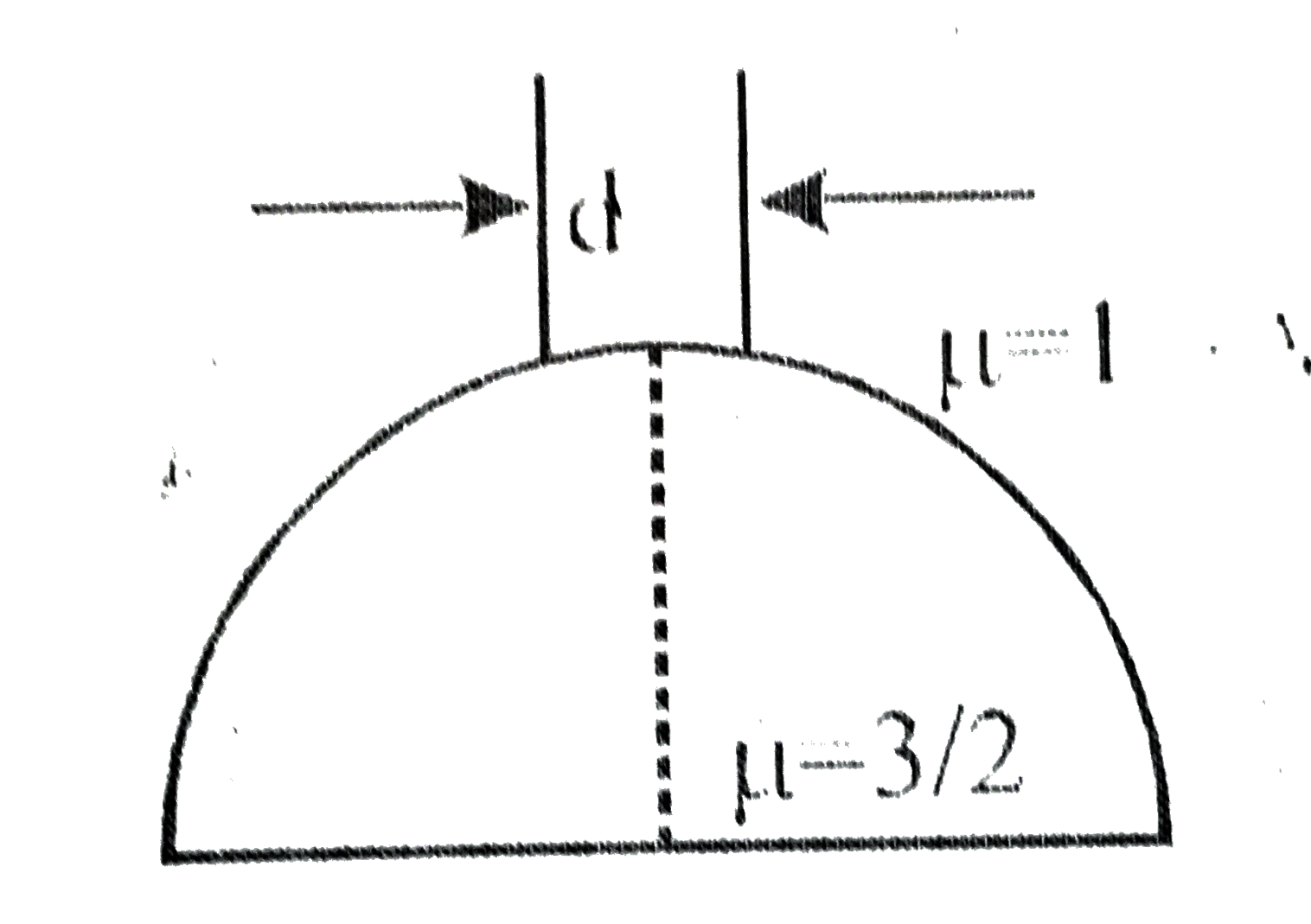A high powered laser beam (λ=630nm) with a beam diameter of 0.1 m is aimed at the Moon, 3.8×108m distant. The beam spreads only because of diffraction, The angular location of the edge of the central diffraction disc is given by sinθ=1.22λd
where d is the diameter of the beam aperture. What is the diameter of the central diffraction disc on the Moon's surface ?
1010.2m
2080.5m
3013.4m
4040.9m
The correct Answer is:C
Wavelength labda=650nm=650×10−9m
Now angular speed θ=Diameter of central disc on moonDistance of moon
Diameter of central dic =θ× Distance of moon
=1.22λd.D[∴thet≈sinθ=1.22λd]
Now D=3.8×108m
and d=0.1m
Diameter of the central disc =1.22×650×10−9×3.8x1080.1
=3013.4 m
Topper's Solved these Questions
- ATOMS, MOLECULES AND NUCLEIBOOK - MODERN PUBLICATIONCHAPTER - ATOMS, MOLECULES AND NUCLEIEXERCISE - MCQ (Level -II)
77 Videos
- ATOMS, MOLECULES AND NUCLEIBOOK - MODERN PUBLICATIONCHAPTER - ATOMS, MOLECULES AND NUCLEIEXERCISE - MCQ (Level -III)
9 Videos
- 15 MAGNETIC EFFECTS OF CURRENTSBOOK - MODERN PUBLICATIONCHAPTER - 15 MAGNETIC EFFECTS OF CURRENTSEXERCISE - Recent Competitive Questions
31 Videos
- CURRENT ELECTRICITYBOOK - MODERN PUBLICATIONCHAPTER - CURRENT ELECTRICITYEXERCISE - RECENT COMPETITIVE QUESTIONS
32 Videos
Similar Questions
A high-powered laser beam (λ=600nm) with a beam diameter of 10 cm is aimed at the Moon, 3.8×105km distant. The beam spreads only because of diffraction. The angular location of the edge of the central diffraction disk is given by
sinθ=1.22λd,
where d is the diameter of the beam aperture. What is the diameter of the central diffraction disk on the Moon's surface?
View SolutionA narrow beam of X-rays falls at a glancing angle of 20∘ on a diffraction grating with a constant of 2.0 μ m. The first diffraction maximum is observed at an angle of 12' to the direction of the beam. Find the wavelenght of the X-rays
View Solution
Knowledge Check
Diffraction of the electron beam is an evidence of the fact that
AElectrons repel each otherBLight has wave propertiesCElectron has wave propertyDElectron has momentumThe central point of the diffraction pattern due to a circular disc is
Aalways darkBalways brightCblurredDnot clearA laser beam having λ=7000 Å and aperture d=10−2m is sent to the moon. What is the angular spread of the beam?
A7×10−4 radianB(7×10−4×10π180)0C7×10−5 radianD72×10−5 radian
The beam emerging from a 1.5 W argon laser (λ=515nm) has a diameter d of 3.5 mm. The beam is focused by a lens system with an effective focal length fL of 2.5 mm. The focused beam strikes a totally absorbing screen, where it forms a circular diffraction pattern whose central disk has a radius R given by 1.22fLλ/d. It can be shown that 84% of the incident energy ends up within this central disk. At what rate are photons absorbed by the screen in the central disk of the diffraction pattern?
View SolutionA beam of diameter 'd' is incident on a glass hemisphere as shown. If the radius of curvature of the hemisphere is very large in comparison to d, then the diameter of the beam at the base of the hemisphere will be

View SolutionA beam of diameter 'd' is incident on a glass hemisphere as shown. If the radius of curvature of the hemisphere is very large in comparison to d, then the diameter of the beam at the base of the hemisphere will be :

View SolutionA beam of diameter 'd' is incident on a glass hemisphere as shown in the figure. If the radius of curvature of the hemisphere is very large in comparision to d, then the diameter of the beam at the base of the hemisphere will be:

View SolutionA beam of diameter 'd' is incident on a glass hemisphere as shown. If the radius of curvature of the hemisphere is very large in comparison to d, then the diameter of the beam at the base of the hemisphere will be

View Solution
